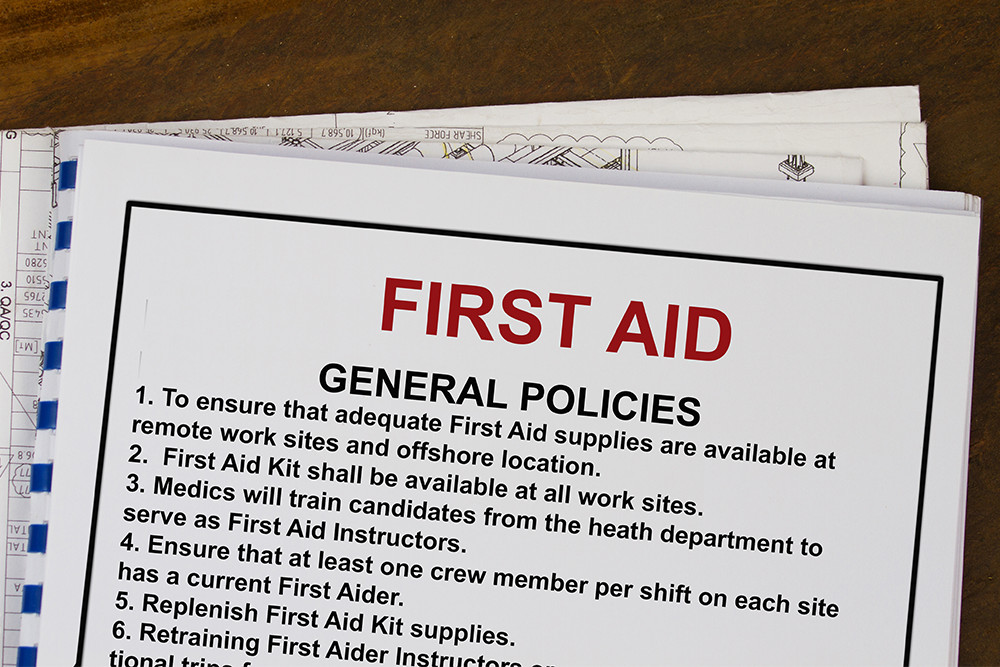
The law says you need qualified first aiders in your workplace. To put it simply, first aiders are people trained to give first aid. First aid is the immediate assistance given to people who have a minor, or serious, illness or injury.
Unfortunately, injuries and workplaces go hand-in-hand. Most workplaces are full of hazards that pose a threat to workers, and potentially, the public. So, it’s not surprising that first aiders are needed. So, as an employer, you might be wondering, how many first aiders do I need?
Why We Need First Aiders
Before we get into specifics, let’s discuss a bit of background. Adequate and appropriate equipment, facilities and first aid personnel are required in the workplace. They’re required under the Health and Safety (First-Aid) Regulations 1981, and employers are the ones who must provide them.
The level of responsibility on the employers to do this, is high. Failure to provide first aiders in the event of injury or sudden illness, could result in the death of an injured person. On top of that, the Health and Safety Executive (HSE) will prosecute, in cases of significant risk or disregard for established standards or poor compliance with the law.
More information on HSE enforcement can be found in this helpful PDF.
First Aid Needs Assessments
As is common in health and safety provisions at work, you should do a needs assessment, also referred to as a risk assessment, to determine the hazards that you need to control with first aid.
Needs assessments are handy, not only to show you how many first aiders you need, but also for demonstrating to the authorities that you’re complying with the law. With this in mind, let’s discuss how you might conduct one.
When carrying out your first-aid needs assessment, consider:
- Is your workplace low or high-risk?
- How many workers do you have?
- Do all of your workers work on-site?
- Does your workplace have a history of accidents?
- Do members of the public come into contact with your work, or workplace?
For an example of how to do your risk assessment, check out this PDF from the HSE. Our first aid needs assessment training course can also guide you through this process.

Amount of First Aiders
The amount of first aiders you need comes down to the results of your risk assessment.
At the very least though, according to the HSE, the legal minimum requirement for first aiders is:
- One first aider for every 50 workers in low-risk workplaces
- One first aider for every 25 workers in high-risk workplaces
Low or High-Risk?
What’s the difference between low-risk and high-risk workplaces?
In low-risk workplaces, the risk resulting in serious injury or illness is low. An office environment is a typical example of this.
High-risk workplaces are areas where dangerous activities take place, such as using machinery or heavy equipment. Examples of high-risk workplaces include construction sites, mines and railways.
Minimum Provision
If your organisation has less than 25 workers, there should still be an appointed person, which we’ll discuss more, later. The minimum provision of first-aid arrangements in this case would be a suitably stocked first-aid kit.
For workplaces that have more than 25 workers, even if it’s a low-risk environment, you should consider providing:
- First aiders
- Additional first-aid equipment
- A first-aid room
It’s not a legal requirement for a first aider to be on site at all times. So, these other first-aid provisions are important, to ensure there’s always some medical help when someone needs it.
What About Schools?
Work in a school? Well there are some slight differences in school environments because there are both employees and students.
Schools are categorised as low-risk. They should have at least one first aider, but this only covers the number of employees.
Two first aiders should be enough to provide sufficient first-aid provision, but make sure you’re going off of what your needs assessment says, because you may need more.
Naturally, the children’s health and safety in schools has to come first. So, someone must also have an up-to-date PFA Certificate, PFA being ‘Paediatric First Aid’. Paediatrics is the branch of medicine that deals with children.
Types of First Aiders
So, we know why we have them, and we know what they are. But did you know there are different types of people responsible for the first aid in a workplace?
Appointed Person
There’ll be an appointed person. They’re in charge of first-aid arrangements. So, they take care of first-aid equipment and facilities, and, in the event of an emergency, they’ll call the emergency services. Despite being in charge, appointed people don’t actually need to have formal first-aid training themselves.
First Aider
First aiders on the other hand, do have proper training to give first aid to an injured or ill person. They’ll use the skills and knowledge acquired in a first-aid course to lessen the risk of serious injuries or death at work.
It’s also worth noting that a first-aid certificate will last for three years. And once it’s expired, the person is no longer competent to be a first-aider. So, be sure all qualifications are up-to-date and courses are retaken every three years.
Emergency First Aider
To become an emergency first aider, a first aider can undergo EFAW, or, Emergency First Aid at Work training. This will allow them to recognize and diagnose injuries or specific health issues.
Emergency first aiders can stop dire medical situations from escalating while waiting for the emergency services to arrive.
First Aid Training for Your Workplace
So, you’re in charge of providing first aid in your workplace. You know that it’s your responsibility but maybe don’t know much about basic first aid itself. Well, you can take a First Aid at Work Course.
These types of courses cover various situations first aiders may encounter, which could help you recognise more hazards and risks in your workplace. While initial Basic First Aid at Work Training must be completed face-to-face, online training is recognised by the HSE as a useful resource for refreshing previously gained knowledge.






















































































































































































































































































































































































































































































































































